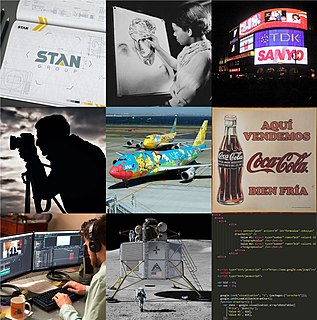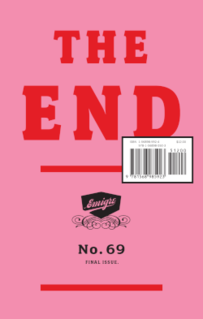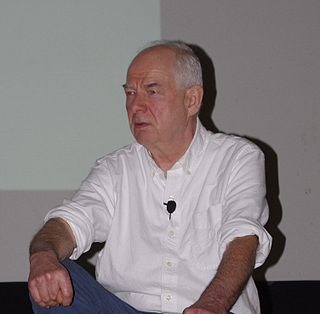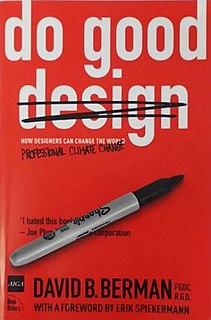
Graphic design is the profession and academic discipline whose activity consists in projecting visual communications intended to transmit specific messages to social groups, with specific objectives. Design is based on the principle of "form follows a specific function".

The Adbusters Media Foundation is a Canadian-based not-for-profit, pro-environment organization founded in 1989 by Kalle Lasn and Bill Schmalz in Vancouver, British Columbia. Adbusters describes itself as "a global network of artists, activists, writers, pranksters, students, educators and entrepreneurs who want to advance the new social activist movement of the information age."

Emigre Fonts is a digital type foundry based in Berkeley, California, that was founded in 1985 by husband-and-wife team Rudy VanderLans and Zuzana Licko. The type foundry grew out of Emigre magazine, a publication founded by VanderLans and two Dutch friends who met in San Francisco, CA in 1984. Note that unlike the word émigré, Emigre is officially spelled without accents.
The First Things First manifesto was written 29 November 1963 and published in 1964 by Ken Garland. It was backed by over 400 graphic designers and artists and also received the backing of Tony Benn, radical left-wing MP and activist, who published it in its entirety in The Guardian newspaper.

Emigre was a (mostly) quarterly magazine published from 1984 until 2005 in Berkeley, California, dedicated to visual communication, graphic design, typography, and design criticism. Produced by Rudy VanderLans and Zuzana Licko, Emigre was known for creating some of the very first digital layouts and typeface designs. Exposure to Licko's typefaces through the magazine lead to the creation of Emigre Fonts in 1985.

Kalle Lasn is an Estonian-Canadian film maker, author, magazine editor, and activist. Near the end of World War II, his family fled Estonia and Lasn spent some time in a German refugee camp. At age seven he was resettled in Australia with his family, where he grew up and remained until the late 1960s, attending school in Canberra. In the late 1960s, he founded a market research company in Tokyo, and in 1970, moved to Vancouver, British Columbia, Canada. Over the course of twenty years, he produced documentaries for PBS and Canada’s National Film Board. He currently resides in Vancouver, British Columbia.
Rudy VanderLans is a Dutch graphic designer, photographer, and the co-founder of Emigre Fonts with his wife Zuzana Licko. Emigre Fonts is an independent type foundry in Berkeley, CA. He was also the art director and editor of Emigre magazine, the legendary journal devoted to visual communications from 1984 to 2005. Since arriving in California in 1981, he has been photographing his adoptive Golden State as an ongoing side project. He has authored a total of 11 photo books on the topic, and staged two solo exhibits at Gallery 16 in San Francisco.
Sheila Levrant de Bretteville is an American graphic designer, artist and educator whose work reflects her belief in the importance of feminist principles and user participation in graphic design. In 1990 she became the director of the Yale University Graduate Program in Graphic Design and the first woman to receive tenure at the Yale University School of Art. In 2010 she was named the Caroline M. Street Professor of Graphic Design.
Rick Poynor is a British writer on design, graphic design, typography, and visual culture.
Herbert Spencer was a British designer, editor, writer, photographer and teacher. He was born in London.
J. Abbott Miller or Abbott Miller is an American graphic designer and writer, and a partner at Pentagram, which he joined in 1999.
Stephen Banham is an Australian typographer, type designer, writer, lecturer and founder of Letterbox, a typographic studio.
Jessica Helfand is a designer, author, and educator. She is a former contributing editor and columnist for Print, Eye and Communications Arts magazine, and founding editor of the website Design Observer. She is Senior Critic at Yale School of Art since 1994, a lecturer in Yale College, and Artist-in-Residence at Yale’s Institute for Network Science. Named the first Henry Wolf Resident in design at the American Academy in Rome in 2010, she is a member of the Alliance Graphique Internationale and the Art Director’s Hall of Fame. In 2013, she won the AIGA medal.
Jeffery Keedy, born 1957, is an American graphic designer, type designer, writer and educator. He is notable as an essayist and contributor to books and periodicals on graphic design. He is also notable for the design of Keedy Sans, a typeface acquired in the permanent collection of the Museum of Modern Art in 2011.

Jonathan Barnbrook, is a British graphic designer, film maker and typographer. He trained at Saint Martin's School of Art and at the Royal College of Art, both in London.
Ernst Bettler is a fictional Swiss graphic designer. He was invented by Christopher Wilson in a 2000 hoax article published in the second issue of Dot Dot Dot, a magazine of visual culture.

Do Good Design: How Designers Can Change The World is a book by Canadian designer David B. Berman, with a foreword by Erik Spiekermann, published by Peachpit Press in January 2009. The book was co-published by AIGA.
Ken Garland was a British graphic designer, photographer, writer and educator. Garland is known for his writing on design and the prolific work of his studio Ken Garland & Associates.
Culture jamming is a form of protest used by many anti-consumerist social movements to disrupt or subvert media culture and its mainstream cultural institutions, including corporate advertising. It attempts to "expose the methods of domination" of mass society.
Edward Wright was a painter, typographer and graphic designer.